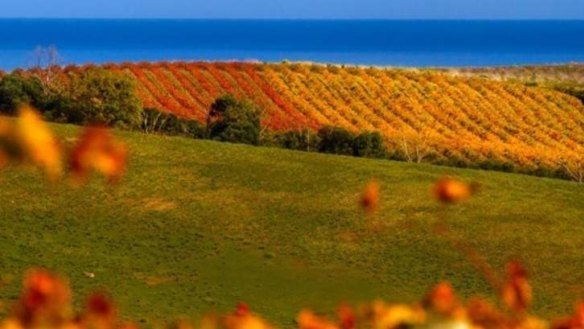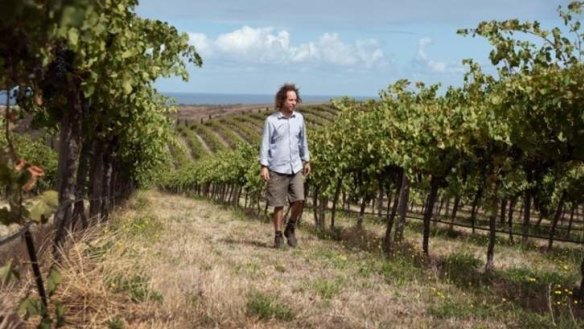McLaren Vale is in need of a white wine champion

Sometimes we have only ourselves to blame. If we view a wine region as a red producer of note, if we buy its shiraz and its grenache and remain colourblind to other possibilities, the inevitable happens: it becomes a red wine region.
That's McLaren Vale today. Red wines now constitute 89 per cent of Vale production, with whites barely registering.
The only white wine of consequence, planting-wise is chardonnay, but its fortunes are fading fast as cooler regions make their play, delivering greater filigree fineness in the glass than the Vale could ever hope to produce. Some Vale makers are grafting their chardonnay vines over to – no surprises here – shiraz, or grenache.

McLaren Vale is in need of a white wine champion, if only to check the growing red wine imbalance, or to make a match with the region's signature dishes King George whiting and garfish. Shiraz is versatile but not quite that versatile.
Having enjoyed success with the Portuguese red grape touriga, Steve Pannell at SC Pannell Wines is toying with the idea of planting the Portuguese white loureiro, one of the bright, appley, aromatic grapes behind vinhoverde.
More than a few makers fancy the chances of the southern Italian fiano, which holds its acidity in the heat, an absolute must in the region's Mediterranean climate. Like chardonnay, fiano carries texture well, which gives the grape added gravitas among foodies. It's become a popular frontrunner, admittedly off a small base. Annual production is believed to be less than 14 tonnes.
And there's vermentino, another Mediterranean lovely that springs from the glass like sauvignon blanc. Drawbacks are few except the grape doesn't show as much depth as its nearest rival, fiano. It likes it simple. Nothing wrong with that.
"I have made a couple of batches of vermentino on the side," says Joe Grilli at Primo Estate, "and I think the potential is very good, but it is unclear if it can take off in a marketing sense."
The man who pioneered fiano in the Vale, the very open-minded Mark Lloyd at Coriole, is now looking further afield to the French picpoul (aka piquepoul; to be released next year) and the Italian grillo (first look in 2016).
"Who knows? These may storm home with wonderful viticulture and exciting wine qualities," he suggests.
But are we asking the wrong question here? Is it essential for a red-dominant region like McLaren Vale to have a white wine champion?
Vale winemaker Justin McNamee of Samuel's Gorge makes only red wines.
He appreciates that makers in his region now play to their strengths. "Gone are the days when wineries are all things to all people.
"Our region excels in rustic, textural bright reds. White wine is not common here and extremely hard to do justice to, but it is not impossible," he says, emphasising the "not".
And anyhow, he throws in as a final tease, maybe the Vale's white wine champion already exists. Maybe it's chenin blanc.
Chenin blanc? Why not? It has a proven record in the region under Coriole and Dowie Doole as something textural and sophisticated with baked apple, herbals, tropical fruits. It even has maverick millennial makers like James Erskine at Jauma entranced, playing up its "natural" side for the naturalists.
There's no argument about its value from Leigh Gilligan at Dowie Doole, who says he has learnt that good chenin in the Vale comes down to site. "We own the 80-plus-year-old Tintookie Vineyard in the highlands of Blewitt Springs," he says. "It grows on deep, grey wind-blown Maslin sands over ironstone and clay, which we believe suit it much better than on the cracking black clay of the Willunga plain."
Dowie Doole believes so strongly in the grape and its versatility that it makes three styles: clean and crisp, funky, barrel and bottled aged and dessert. Coming soon is a bottle-aged sparkling chenin.
So, finally, having tastedsome of the new and the not-so-new white grape varieties and given some thought as to whether McLaren Vale even needs a white wine champion, the question still nags: what to drink with Kangaroo Island King George whiting, Coorong mullet or blue swimmer crab and prawn dumplings when dining at McLaren Vale stalwarts Salopian Inn, or Star of Greece at Port Willunga?
And, no, McLaren Vale shiraz or grenache won't do.
In search of a white wine champion: the candidates
Assyrtiko: Keeps its cool – and acidity – in the heat. Originally from Santorini, "assy" has real potential if only we can pronounce it. Hint: "a-seer-tee-ko." A bit of a sleeper. Mineral, citrus, acidity.
Fiano: Sturdy and bold are often used to describe fiano, which hails from Campania in southern Italy. Easy to pronounce and drink, it's an odds-on favourite. Pear, generous and textural.
Greco: A grape of southern Italy, Greco works dry or sweet. Usually viewed as a blending option, it can work solo. Outside chance. Aromatic.
Picpoul/Piquepoul: A bit of a dark horse but gaining traction for its versatility, coming in both white and red versions. Its home is the south of France. Citrus, fresh acidity.
Verdejo: A grape of north-western Spain, verdejo has no known connection to the grape verdelho but suspect confusion would still rein. Herbaceous, honey flavours.
Vermentino: Easygoing, lively grape found on Sardinia and Corsica, vermentino sounds exotic while remaining immensely drinkable. Aromatic and clean.
- More:
- Drinks